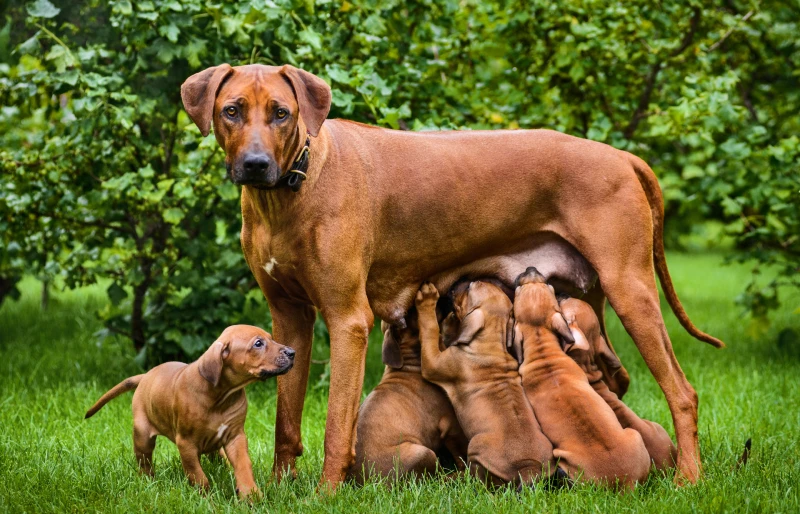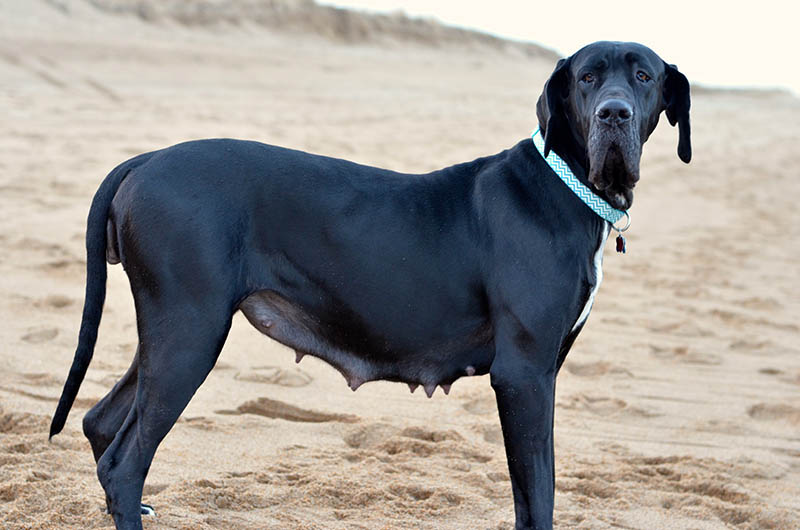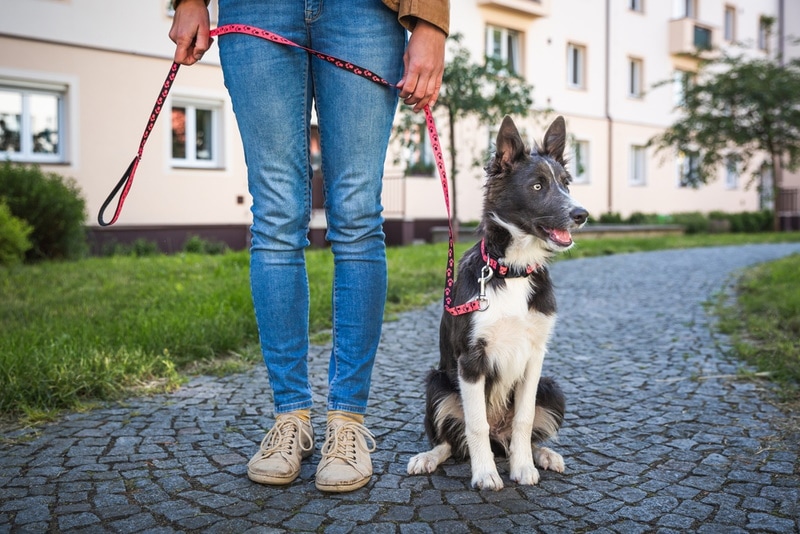Can Dogs Be Overbred? Vet Reviewed Risks & Consequences
Updated on

Click to Skip Ahead
Dogs have always been humans’ most loyal companions, especially in times of need. That’s likely why first-time dog ownership soared during the Covid-19 lockdown. But with an increase in demand comes a risk of overbreeding. Yes, when dog breeding is prioritized over the dog’s health and well-being, the breed is said to be overbred.
Overbreeding leads to plenty of health problems, including diseases, behavioral issues, and physical deformities. But the risks of overbreeding are not limited to health concerns. Below, we look at other consequences of overbreeding.
What Is Overbreeding?
Overbreeding is the practice of continuous breeding without any concern for the health or quality of the breeding stock. It can occur when irresponsible breeders prioritize quantity and profits, disregarding the health of the mother and their puppies.
Inbreeding occurs when two related dogs are bred. If a particular bloodline is continuously bred from, this can amplify both the good and bad attributes of the breed. The higher the degree of inbreeding the higher the risk of puppies developing both known and unknown inherited disorders.
Particular dog breeds and pedigree dogs have been bred by selective breeding of specific traits. Dogs are chosen for breeding often primarily based on their physical appearance and this can cause a number of health and welfare issues.
The most obvious example of this is the popularity of flat faced (brachycephalic) breeds such as Pugs and French Bulldogs. These flat faces and nose shapes make them prone to many eye conditions including eyelash disorders, cherry eye, eyelid disorders, and ulcers.
Flat-faced breeds are also susceptible to Brachycephalic Obstructive Airway Syndrome (BOAS). The condition comprises their breathing ability, making them more likely to have fatal conditions, including heatstroke. The more these dogs are bred, the more their health can be compromised, with their popularity affecting their wellbeing.

Can Dogs Be Overbred?
As established, overbreeding is possible and quite common. The following breeds are often overbred due to their popularity:
The 4 Reasons for Overbreeding
There are many reasons dogs are overbred. Some are due to greed, while others result from sheer negligence.
1. Profit
Many breeders overbreed certain dogs due to their high demand. They neglect the dogs’ health due to their greed for increased profits.
2. Favoring Traits
Some dogs undergo excessive overbreeding because buyers prefer certain features- good and bad. For example, buyers may favor the following traits:
- Physical appearance (muzzle length, coat color, etc.)
- Size
- Temperament
- Intelligence and energy level
Since the demand for these traits is high, breeders may find it profitable to overbreed the same bloodline.
3. Lack of Regulation
In many places, there are little to no regulations for breeding practices. The local and federal governments don’t have stringent regulations for breeding, leading to irresponsible practices.
4. Inadequate Knowledge
There’s a common trend of people showing off the “unusual” features in their dogs. Since these features come across as cute or adorable, breeders intentionally breed dogs with these deformities.
The Toadline Bully is an example of this practice.This breed has extremely short legs and a very muscular body. People with little or no knowledge of the animal’s health may find their appearance desirable, but these dogs face a lifetime of skeletal problems,heart problems, breathing difficulties and even an inability to fully close their eyes.

The 4 Consequences of Overbreeding
Overbreeding does not only harm dogs but also burdens shelters and rescues. Here are some major consequences of overbreeding dogs:
1. Health Risks
Immediate risks and welfare concerns of overbreeding include hygiene issues at the breeders. Parasites and deadly viruses such as parvovirus can spread quickly. The mother’s health can be compromised by problems such as malnutrition, hypoglycemia and mastitis.
Overbreeding also causes health issues because it increases the chance of a recessive trait passing down to the next generation. A recessive trait is a genetic characteristic that only passes to the offspring if it gets one copy from each parent.
Many breeders resort to inbreeding to preserve desirable traits in dogs. So, they breed closely related dogs, like parents and offspring or siblings.
While this helps retain favorable traits, it also increases the likelihood of the offspring inheriting a copy of the recessive trait from each parent. That increases genetic disorders in overbred dogs.
Some examples of these diseases are:
- Eye Problems: Flat-faced or short-nosed breeds, such as Pekingese, Bulldogs, and Pugs, undergo excessive overbreeding leading to protruding eyes with associated issues.Other genetic eye disorders include some forms of cataracts and glaucoma.
- Joint Issues: Hip and elbow dysplasia can be more common in overbred dogs.
- Heart Problems: Degenerative valve disease or endocarditis is the most common heart ailment in dogs. But other diseases like patent ductus arteriosus, pulmonic stenosis, and atrioventricular septal defects can occur more often due to overbreeding.
2. Dystocia
Overbreeding is particularly hard on female dogs, as it increases the risk of dystocia or abnormal delivery and labor. Dystocia occurs when there’s a problem in the pup’s normal passage through the birth canal.
It may occur due to several reasons:
- Large pups
- Improper pup positioning
- Narrow birth canal
Some signs of dystocia include lethargy and prolonged weakness. If not treated promptly, dystocia can be fatal to both the pup and the mother.
Responsible breeders limit breeding a female dog to four to six litters because any frequency of more than that is harmful to the dog.
Overbreeding often results in dystocia because it weakens or overstretched the female reproductive tract. In some cases, breeders may breed dogs that are too young or old. It can also cause dystocia since the reproductive tract may be too narrow or weak.
Some breeds also have a susceptibility to dystocia due to their physical characteristics. For example, brachycephalic dogs have narrow pelvises. So, they may face difficulty in delivering their pups who have big shoulders and heads.

3. Overfilling of Shelters
When people buy instead of adopting, many pups stay in rescues and shelters their whole lives. According to the American Society for the Prevention of Cruelty to Animals (ASPCA), 6.3 million animals enter animal shelters every year. Of these, 3.1 million are dogs. Only 2 million dogs are adopted annually, leaving the rest in shelters.
Every year, 390,000 dogs are euthanized in shelters. Although the number has decreased since 2011, it’s still alarmingly high.
If people adopted pets from shelters instead of creating dogs for their desired traits, there would be fewer dogs in shelters.
4. Pet Ownership Issues
When people buy overbred dogs, they often only consider their traits and appearance. It’s only after bringing the dog home that the owners become aware of their pet’s health problems.
One, caring for a pet like this could be very costly. Two, it results in increased stress and responsibility for the owners. It is also heartbreaking to see your pet suffer or pass away due to prolonged health conditions.
Some people might also abandon their pets when they learn about their health conditions. It further increases the burden on animal shelters, resulting in canine suffering and overpopulation.

Monitoring Overbreeding
The American Kennel Club is the only purebred US registry with a kennel inspection program.
Since 2000 inspectors from the program have conducted more than 70,000 inspections across the country. They work with breeders to correct deficiencies and inform breeders about effective procedures.
Although the AKC does not have penal/regulatory authority, if breeders have major kennel deficiencies they may lose AKC privileges and in some cases fines will be imposed or law enforcement authorities contacted.
Conclusion
We all love watching cute dog videos on the Internet. But the regard for cuteness glosses over the issue of overbreeding. Many dogs are overbred for their desirable traits, such as certain physical characteristics.
While this might be profitable for breeders and exciting for buyers, it harms the dogs. Apart from harming the female who has to give birth multiple times, it can also increase the risk of genetic disorders in offspring.
Caring for these pets can be hard and costly. The dogs may also have to go through pain and suffering throughout their lifetime. Therefore, interested buyers must conduct thorough research into their chosen breed and potential issues. Only buy from a reputable breeder who does the appropriate health tests of the parents and check the breeding history of the mother. Even better, adopt rather than shop, if possible.
Featured Image Credit: olgagorovenko, Shutterstock














